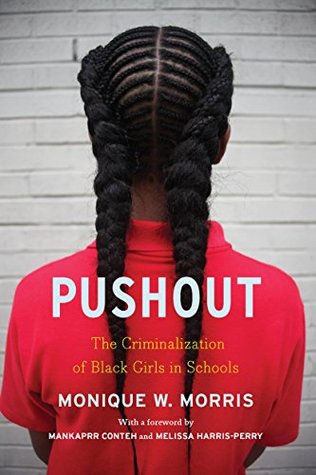More on this book
Community
Kindle Notes & Highlights
Read between
December 22, 2020 - November 1, 2021
To be “loud” is a demand to be heard. To have an “attitude” is to reject a doctrine of invisibility and mistreatment.
If the curriculum being taught does not even consider the unique needs and experiences of Black girls seeking to climb out of poverty and the ghetto, as is most often the case, do they really have equal access to education?
Sadly, many schools are dominant structures, sustaining our society’s racial and gender hierarchy.
Black girls in classrooms across the country have been granted permission to fail by the implicit biases of teachers that lower expectations for them.
Still, it is important to remember that implicit bias is often inconsistent with a person’s stated values, so a teacher may believe that he or she treats all students the same even while aspects of their engagement are reflecting latent biases.
Why do adults get mad when strong girls ask questions?
“Now that’s when you talk the most . . . they want you to sit at a table,” Leila said. “I been wanting to tell her something since nine o’clock! . . . It’s not just ’cause they’re Black. If you’re born poverty-stricken, you ain’t got no recess. The only time to talk is during lunch or after school. Y’all ain’t got no sports. Y’all ain’t got no activities. You don’t have nothin’ to be proud of at your school. You ain’t paint nothing on the walls, or participate in nothing. You just coming from nine [o’clock] . . . to four or three-thirty.”
Every girl is unique, but understanding widely shared experiences connected to structural forces bigger than us all would go a long way toward supporting the success and education of Black girls.
children in carceral settings will create family structures in order to normalize what can be an otherwise dehumanizing experience.
A more productive and effective approach might be to facilitate collaborative learning spaces where girls are encouraged to explore their relationships with each other along with why they reenact “arguments” as a way to demonstrate familial bonds.
The structure fails to meet girls where they are and guide them through their problems, which in all likelihood leads to exacerbated challenges on the other end instead of leading them down healthier, safer paths.
If a girl doesn’t understand the material, why can’t she ask a question? Why must she stay silent and work alone, especially if that is inconsistent with her best learning style?
Education is likely to be their best chance to shape a better life—their best chance to rebound from their conviction histories and emerge as productive, engaged citizens capable of charting new paths toward redemption.
Thurgood Marshall wrote in his opinion for Procunier v. Martinez (1974), “When the prison gates slam behind an inmate, he does not lose his human quality; his mind does not become closed to ideas; his intellect does not cease to feed on a free and open interchange of opinions; his yearning for self-respect does not end; nor is his quest for self-realization concluded.”
long as there are juvenile detention facilities, the schools inside must uplift the potential of each student, not her deficits.
first step is for all those investing their time and energy in the fight for racial justice—advocates, scholars, organizers, and others—to stop measuring the impact of the criminal legal system simply by the numbers of people who are incarcerated. Incarceration is now framed as our generation’s greatest civil and human rights challenge.
Our work on behalf of Black girls cannot be about respectability politics. Etiquette lessons can be a part of other social practices and agendas, but if our anti-criminalization efforts are to have teeth, schools must look far beyond whether our girls are wearing tight pants, crop tops, or pink extensions in their braids. The crisis of criminalization in schools is an opportunity to focus on the policies, systems, and institutions—in other words, the structures—that place women and girls at risk of exploitation in private and public domains.
Just because young women and girls are affected by similar conditions as their male counterparts doesn’t mean that they experience these conditions in the same way.
’Cause we’ve been doing prisons for over four-hundred-something years, and they clearly don’t work. So, let’s try restorative justice for about one hundred [years].”
Imperfect implementation should not lead to an abandonment of the idea.
Joseph Betancourt, Alexander Green, J. Emilio Carrillo, and Owusu Ananeh-Firempong define cultural competency as acknowledging and incorporating “at all levels—the importance of culture, assessment of cross-cultural relations, vigilance toward the dynamics that result from cultural differences, expansion of cultural knowledge, and adaptation of services to meet culturally unique needs.”7 They also note that a culturally competent system has as its foundation, “an awareness of the integration and interaction of health beliefs and behaviors, disease prevalence and incidence, and treatment
...more


